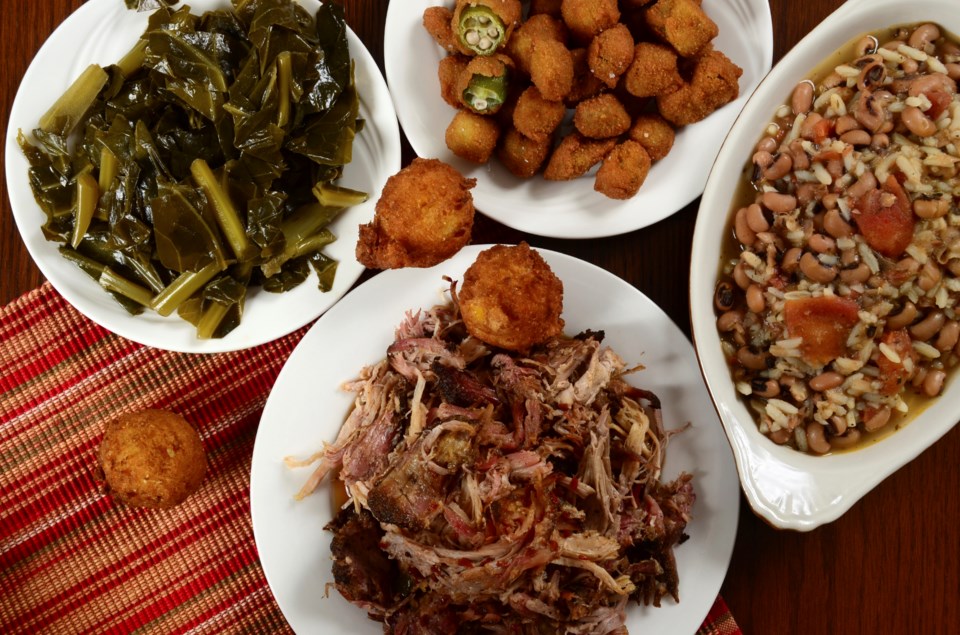It’s Black History Month, and as a woman of colour, I have been known to take it pretty seriously (I ask my friends to research a person of colour in history then we drink wine and all share what we learn...yes this really has happened!). Call me crazy, but thinking about a bunch of folks taking a boat ride across the world to kidnap other humans and enslave them really rubs me the wrong way, especially because it’s still happening in the world today. It makes me wonder how far have we really come?
I think that this is a good time to reflect on and celebrate African-American/Canadian culture. You may be surprised to learn about the rich presence of African-Canadians that Vancouver once had (but that’s a topic for a different column). This is a food/wellness column, so let’s talk about what I know best, food. More specifically, soul food!
You have probably heard of the term, and instantly get flashes of yummy exotic items streaming through your head. Maybe you think of New Orleans, collard greens, cornbread, shrimp perhaps? You may be surprised to know that’s not how this well-known flavourful genre of food started out.
The actual meaning of soul food is “traditional southern African-American food.” It originated during American slavery, when slaves were given the undesirable cuts of meat and leftovers from slave owners – basically whatever the slave owners didn’t want to eat. The slaves worked with what they had and this actually carried on after slavery was abolished, as many former slaves lived in extreme poverty and could only afford the off-cuts of meat and offal (internal organs, intestines and such). Eventually farming, fishing and hunting provided them with more choices such as possum, squirrel and rabbit.
So what is an example of “traditional” soul food? Think oxtail soup, chitterlings (pig's small intestines) and boiled and pickled pigs feet, to name a few.
The actual term soul food was not common until the ‘60s where the word soul was used to describe basically everything in African-American culture as a means to reclaim their part of American cultural legacy. Others began to recognize “soul food” as a culinary, cultural, and marketing buzzword and it became the new label for the very best home-cooking passed down through the generations. If you ask people today what soul food is, I bet most will talk about a home-cooked meal of sorts made with love. But what it really was, was basic cooking with roots in the rural South.
Soul food recipes have been passed down through African American families through verbal stories and recipe cards, and they vary slightly in ingredients from region to region. For example, seafood makes an appearance in coastal areas, and it has been refined and changed through generations of people.
Soul food today is different than it was 100 years ago. It tends to be high in sugar, breaded and full of refined carbs, all smothered in gravy. Your body sure takes a beating after meals like that. Even collard greens and other veggies are cooked with pork fat to add flavours. If you are a vegetarian/vegan this could be a hard one to swallow (pun intended)
Here’s a vegan take on a popular well-known dish;
Vegan Cornbread
Ingredients:
1 small flax egg (mix 1/2 tbsp flaxseed meal and 1 1/2 tbsp of water)
100mL plain unsweetened coconut milk
1 tsp lemon juice or apple cider vinegar
1/4 tsp baking soda
2 tbsp vegan butter, melted
1/4 cup coconut sugar
1 tbsp unsweetened applesauce
1 pinch sea salt
100mL fine yellow cornmeal (organic and non-gmo)
100mL unbleached all purpose flour
Directions
• Preheat oven to 350 F and grease two small ramekins or two muffin tins.
• Prepare the flax egg in a small bowl and let set for a few minutes to achieve an "eggy" texture. • Measure out coconut milk and add lemon juice and let curdle for a few minutes. Then add baking soda and stir once more. Set aside.
• In a mixing bowl, add melted butter and sugar and whisk vigorously to combine. Then add applesauce, flax egg, and whisk once more. Next add coconut mixture and whisk vigorously again to combine.
• Next add salt, cornmeal, flour and stir with a spoon until just incorporated. It will look thin and somewhat lumpy. That's what you're going for.
• Divide batter between greased ramekins or muffin tins (it may take up to three muffin tins)
Bake for 28-35 minutes, or until the edges are golden brown and a toothpick or fork inserted into a center comes out clean.
• Let rest in the cooking dish for a few minutes before serving.



